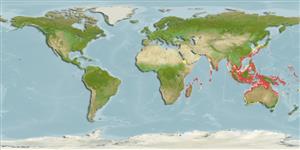Environment: milieu / climate zone / depth range / distribution range
Ecology
Marine; reef-associated; depth range 35 - 50 m (Ref. 9806). Tropical
Indo-West Pacific: East Africa to Indonesia, north to southern Japan, south to northern Australia.
Size / Weight / Age
Maturity: Lm ? range ? - ? cm
Max length : 35.0 cm TL male/unsexed; (Ref. 9806)
Inhabits rubble substrates in channels between sheltered inner reefs or in deep sandy lagoons around coral patches (Ref. 48637). Solitary or in pairs (Ref. 90102). Generally uncommon species (Ref. 9710) that inhabits coral reefs and flat bottoms in coastal areas. Feeds on benthic invertebrates.
Life cycle and mating behavior
Maturity | Reproduction | Spawning | Eggs | Fecundity | Larvae
Matsuura, K., 2001. Ostraciidae. Boxfishes. p. 3948-3951. In K.E. Carpenter and V. Niem (eds.) FAO species identification guide for fishery purposes. The living marine resources of the Western Central Pacific. Vol. 6. Bony fishes part 4 (Labridae to Latimeriidae), estuarine crocodiles. FAO, Rome. (Ref. 9806)
IUCN Red List Status (Ref. 130435: Version 2024-1)
Threat to humans
Venomous
Human uses
Fisheries: of no interest; aquarium: potential
Tools
Special reports
Download XML
Internet sources
Estimates based on models
Preferred temperature (Ref.
123201): 24.3 - 28.4, mean 27.4 °C (based on 123 cells).
Phylogenetic diversity index (Ref.
82804): PD
50 = 0.5039 [Uniqueness, from 0.5 = low to 2.0 = high].
Bayesian length-weight: a=0.03548 (0.01723 - 0.07305), b=2.81 (2.62 - 3.00), in cm total length, based on LWR estimates for this (Sub)family-body shape (Ref.
93245).
Trophic level (Ref.
69278): 3.5 ±0.37 se; based on food items.
Resilience (Ref.
120179): High, minimum population doubling time less than 15 months (Fec assumed to be > 10,000).
Fishing Vulnerability (Ref.
59153): Low vulnerability (25 of 100).
Nutrients (Ref.
124155): Calcium = 42.9 [18.4, 104.1] mg/100g; Iron = 0.617 [0.311, 1.405] mg/100g; Protein = 18.4 [16.1, 20.5] %; Omega3 = 0.112 [0.058, 0.209] g/100g; Selenium = 38.3 [19.9, 78.1] μg/100g; VitaminA = 48 [14, 167] μg/100g; Zinc = 1.06 [0.72, 1.57] mg/100g (wet weight);
